On The Trail with Susan
Travels in France
with the Dark Madonna
Part of me still is there in the land of the Dark Madonna, medieval villages, savored and savory cuisine, world class museums, and Gothic
cathedrals. | I've been in love with France since I was a kid. Now I have
the privilege of being a small part of that enchanting land, its people,
its culture, its past, and its enigmas. I traveled in France in December and January ('03 and '04), first with
my husband, John, then with my friend, French author Monique Fillion, to
explore the mysteries of the Dark Madonna, also known as the Black
Virgin. | 
Image of Egyptian Isis and Horus, one of the earliest Dark Madonnas in the Throne of Wisdom posture, Louvre Museum, Paris |
The seeker finds these small, intentionally-dark
mother-with-child images throughout the south of France and beyond,
usually in churches and cathedrals.
Why are they dark? After much exploration, I find that their secrets
remain at least partly hidden, like the Dark Madonnas themselves. Often
they rest in side chapels or in crypts, sometimes protected by glass or
screening.
For centuries, pilgrims have brought their troubles and hopes to these
dark figures, leaving behind ex-votos -- thanks for miracles wrought and
prayers answered. Clues lead deeper. As we have learned from Dan Brown's
Da Vinci Code, early strands of Christianity, especially those of Mary
Magdalene as an early church leader, went underground, refugees from
persecution and accusations of heresy. Dark Madonnas most often are
found in places linked to Mary Magdalene, on sites once sacred to
ancient goddess worship, or where the Gnostic-inspired Cathar sect
thrived until it was cut down as heresy.
I have concluded that the Dark Madonna, like many symbols, can mean
whatever the seeker wants her to mean. For some, she brings healing. For
others, she offers a glimpse of the soul. For me, the Dark Madonna
emerges from a long-hidden past where female wisdom commanded respect.
Her darkness urges us to reclaim this part of our humanity which remains
critical to healing a world now sadly out of balance.
On my journey in France, I savored the foods of the people and their
land, from boat-shaped cookies called navettes to the crown-shaped
gallettes des rois (cakes of kings) of Epiphany. The fruits of the lands
of the Dark Madonnas have their own stories and traditions that reach
back to a long and hidden past.
The images here are from my travels in France searching for the Dark Madonna. | Click on the images for a larger photo.
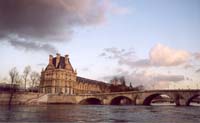
Paris from the Seine
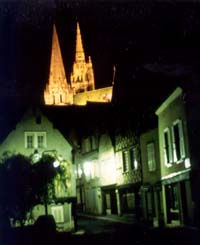
The town of Chartres, in the cradle of agriculture south of Paris, with the spires of Notre Dame de Chartres in the background. In the famous stained glass windows of the cathedral are thousands of images, including Dark Madonnas and bread.
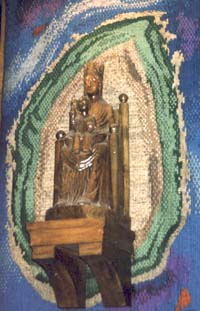
Notre Dame Sous Terre (Our Lady Underground) in the crypt of Notre Dame de Chartres, one of the most powerful places of the Dark Madonna. This is a replica of the old Dark Madonna, one of many destroyed during the French Revolution. Pilgrims still come by the thousands to be in the presence of Notre Dame Sous Terre, whose origins reach back to a pre-Christian image venerated in this place.
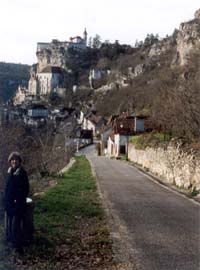
Susan on the road to the famous pilgrimage center of Rocamadour, built on cliffs in the Dordogne in the Southwest of France.
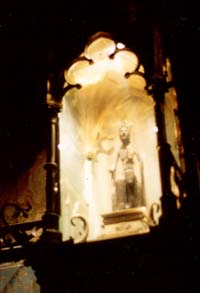
The Dark Madonna of Rocamadour, a gilded wooden statue from the 12th
century or earlier. She reigns in the chapel of St. Saviour's Church, at the top of a 222-step staircase, in a place where druids once worshipped. Rocamadour gives its name to a rich walnut cake and a savory
goat cheese.
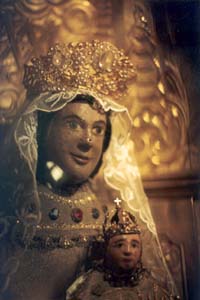
Notre Dame de Marceille (sic), 11th or 12th century, in Limoux, close to the Cathar stronghold of Rennes-le-Chateau. The Dark Madonna of Marceille, like the one in Rocamadour, is only about three feet tall and behind a protective covering.
|
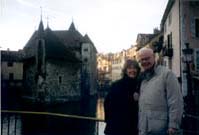
John and Susan in Annecy, the "Venice of the French Alps."
| 
Susan enjoying a fourteen-course dinner on New Year's Eve (St. Sylvester) with friends in Thönes, in the French Alps.
| 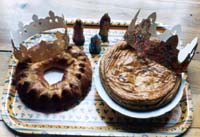
Gallettes des Rois, cakes of kings, to commemorate Epiphany and the journey of the magi to honor the Christ child. Hidden in each cake is a tiny ceramic figurine. The one who finds it reigns as king or queen of the celebration.
|
![L'Eglise des Trois Saintes, Church of the Three [women] Saints](2trois_saintes.jpg)
L'Eglise des Trois Saintes, Church of the Three [women] Saints, in Les Saintes Maries de la Mer, home of the legend of the landing on the Mediterranean shores of a boat of refugees from Egypt including three Marys including Mary Magdalene and a girl named Sara.
| 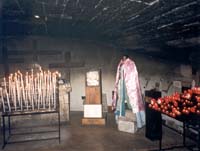
Ste. Sara "the Egyptian," in the crypt of the Church of the Three Saints. Gypsies venerate little Sara as their saint, and honor her each May with a festival and a procession to the sea.
| 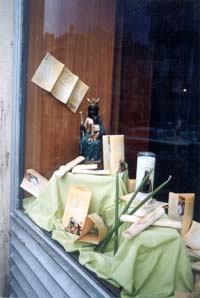
Window display in Marseilles showing Notre Dame de la Confession, green candles, and boat-shaped cookies called navettes. On Candlemas, the Festival of Light, celebrants bring the Dark Madonna from the crypt of the Basilica of St. Victor and, carrying green candles, they process to a bakery where they enjoy the navettes, recalling the journey of the three Marys and Sara.
|
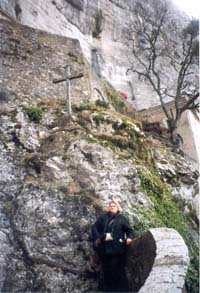
Monique on the way to the cave of Mary Magdalene at La Ste. Baume, where, after preaching to the people, La Madeleine purportedly lived, naked and prayerful, until her death forty years later.
| 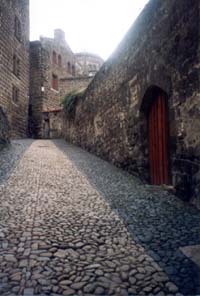
A street in Le-Puy-en-Valey, a medieval town built around a volcano
cone (puy) in the Auvergne region, which has the most Dark Madonnas. Le Puy, an ancient druid site and location to a Temple of Diana, remains a major pilgrimage center and a stop for pilgrims on the road to
Compostela.
| 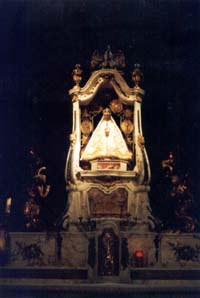
The Dark Madonna of the Cathedral de Notre-Dame, one of the most famous of all Dark Madonnas, celebrated here for centuries. She is the only Dark Madonna I saw holding center stage on the main altar of a cathedral.
|
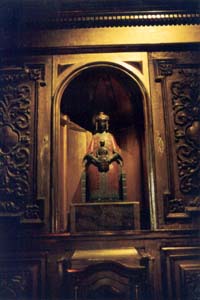
The "other" Dark Madonna of Le Puy, housed in a separate chapel of the cathedral. Sipping coffee in a bar with the owner, the town's minister of culture, Monique and I learned that this Dark Madonna, with roots in Egypt, has perhaps more historical significance than her more famous sister on the main altar.
| Click on an image
for a larger view.
| 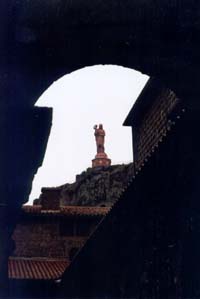
Notre-Dame-de-France, the huge golden statue atop Le Puy's volcano cone, and made from 213 cannons from the Crimean War. She stands watch with her child over a vast and mysterious landscape.
|

Meet Susan
Contact Information
Susan's Books | Articles | Dates In Women's History
Recipe for Justice!

©opyright 1999-, All Rights Reserved
www.sbvoices.com
|